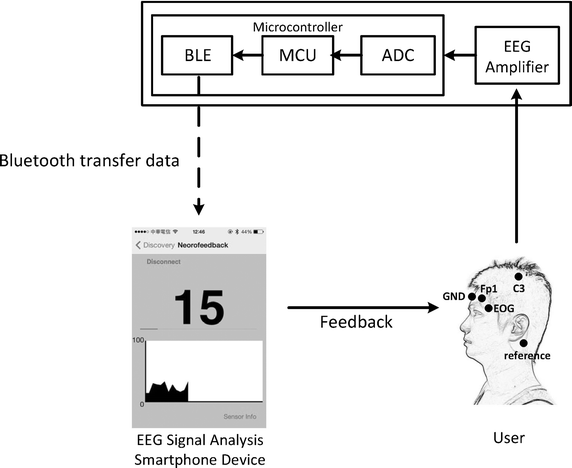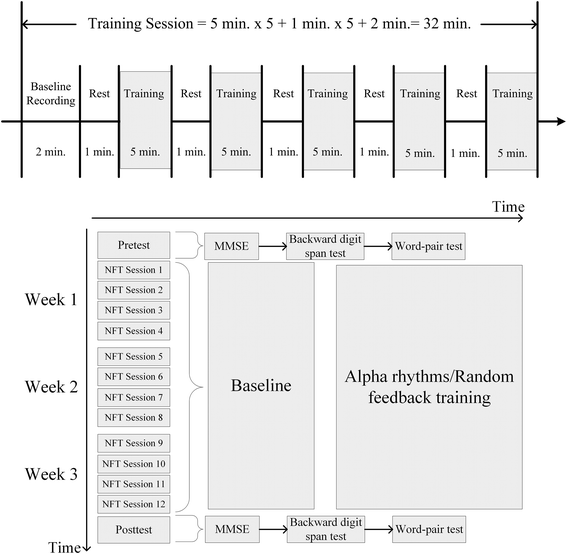Portable wireless neurofeedback system of EEG alpha rhythm enhances memory
- PMID: 29132359
- PMCID: PMC5684759
- DOI: 10.1186/s12938-017-0418-8
Portable wireless neurofeedback system of EEG alpha rhythm enhances memory
Abstract
Background: Effect of neurofeedback training (NFT) on enhancement of cognitive function or amelioration of clinical symptoms is inconclusive. The trainability of brain rhythm using a neurofeedback system is uncertainty because various experimental designs are used in previous studies. The current study aimed to develop a portable wireless NFT system for alpha rhythm and to validate effect of the NFT system on memory with a sham-controlled group.
Methods: The proposed system contained an EEG signal analysis device and a smartphone with wireless Bluetooth low-energy technology. Instantaneous 1-s EEG power and contiguous 5-min EEG power throughout the training were developed as feedback information. The training performance and its progression were kept to boost usability of our device. Participants were blinded and randomly assigned into either the control group receiving random 4-Hz power or Alpha group receiving 8-12-Hz power. Working memory and episodic memory were assessed by the backward digital span task and word-pair task, respectively.
Results: The portable neurofeedback system had advantages of a tiny size and long-term recording and demonstrated trainability of alpha rhythm in terms of significant increase of power and duration of 8-12 Hz. Moreover, accuracies of the backward digital span task and word-pair task showed significant enhancement in the Alpha group after training compared to the control group.
Conclusions: Our tiny portable device demonstrated success trainability of alpha rhythm and enhanced two kinds of memories. The present study suggest that the portable neurofeedback system provides an alternative intervention for memory enhancement.
Keywords: Alpha rhythm; Bluetooth; Memory; Neurofeedback; Wireless.
Figures









Similar articles
-
Neurofeedback of Alpha Activity on Memory in Healthy Participants: A Systematic Review and Meta-Analysis.Front Hum Neurosci. 2021 Jan 5;14:562360. doi: 10.3389/fnhum.2020.562360. eCollection 2020. Front Hum Neurosci. 2021. PMID: 33469422 Free PMC article.
-
Neurofeedback training with a low-priced EEG device leads to faster alpha enhancement but shows no effect on cognitive performance: A single-blind, sham-feedback study.PLoS One. 2019 Sep 4;14(9):e0211668. doi: 10.1371/journal.pone.0211668. eCollection 2019. PLoS One. 2019. PMID: 31483789 Free PMC article.
-
Neurofeedback training of EEG alpha rhythm enhances episodic and working memory.Hum Brain Mapp. 2016 Jul;37(7):2662-75. doi: 10.1002/hbm.23201. Epub 2016 Apr 1. Hum Brain Mapp. 2016. PMID: 27038114 Free PMC article. Clinical Trial.
-
Efficacy, Trainability, and Neuroplasticity of SMR vs. Alpha Rhythm Shooting Performance Neurofeedback Training.Front Hum Neurosci. 2020 Mar 20;14:94. doi: 10.3389/fnhum.2020.00094. eCollection 2020. Front Hum Neurosci. 2020. PMID: 32265676 Free PMC article.
-
Can neurofeedback training enhance performance? An evaluation of the evidence with implications for future research.Appl Psychophysiol Biofeedback. 2005 Dec;30(4):347-64. doi: 10.1007/s10484-005-8421-4. Appl Psychophysiol Biofeedback. 2005. PMID: 16385423 Review.
Cited by
-
Neurofeedback of Alpha Activity on Memory in Healthy Participants: A Systematic Review and Meta-Analysis.Front Hum Neurosci. 2021 Jan 5;14:562360. doi: 10.3389/fnhum.2020.562360. eCollection 2020. Front Hum Neurosci. 2021. PMID: 33469422 Free PMC article.
-
Neurofeedback training with a low-priced EEG device leads to faster alpha enhancement but shows no effect on cognitive performance: A single-blind, sham-feedback study.PLoS One. 2019 Sep 4;14(9):e0211668. doi: 10.1371/journal.pone.0211668. eCollection 2019. PLoS One. 2019. PMID: 31483789 Free PMC article.
-
Sharpening Working Memory With Real-Time Electrophysiological Brain Signals: Which Neurofeedback Paradigms Work?Front Aging Neurosci. 2022 Mar 28;14:780817. doi: 10.3389/fnagi.2022.780817. eCollection 2022. Front Aging Neurosci. 2022. PMID: 35418848 Free PMC article. Review.
-
Effects of an Integrated Neurofeedback System with Dry Electrodes: EEG Acquisition and Cognition Assessment.Sensors (Basel). 2018 Oct 11;18(10):3396. doi: 10.3390/s18103396. Sensors (Basel). 2018. PMID: 30314263 Free PMC article.
-
Comparative effectiveness of electroencephalogram-neurofeedback training of 3-45 frequency band on memory in healthy population: a network meta-analysis with systematic literature search.J Neuroeng Rehabil. 2025 Apr 24;22(1):94. doi: 10.1186/s12984-025-01634-8. J Neuroeng Rehabil. 2025. PMID: 40275307 Free PMC article. Review.
References
MeSH terms
Grants and funding
LinkOut - more resources
Full Text Sources
Other Literature Sources
Medical

